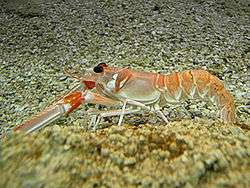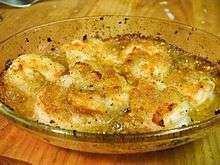Scampi



Scampi includes various culinary preparations of certain crustaceans, commonly Nephrops norvegicus (the Norway lobster, also known as "Langoustine" or "Dublin Bay Prawns" and sometimes itself called "scampi"[1]), or a similar lobster such as Metanephrops, as well as shrimp or prawns. Scampi preparation styles vary regionally. While the United Kingdom legally defines scampi specifically as Nephrops norvegicus, other similar lobsters are considered scampi worldwide. Monkfish tail was sometimes illegally used and sold as scampi in the United Kingdom in the past[2] contravening the Fish Labelling (Amendment) England Regulation 2005 and Schedule 1 of the Food Labelling Regulations 1996.
Name
Scampi is the Italian plural of scampo, Nephrops norvegicus. In English, scampi is used as singular, plural, or uncountable. The Italian word may be derived from the Greek κάμπη kampē ("bending" or "winding").[3]
Nephrops norvegicus
Langoustines or Norway lobsters – Nephrops norvegicus – are roughly the size of a large crayfish and fished from silty bottom regions of the open Atlantic Ocean, and parts of the Mediterranean. The fleshy tail of the Norway lobster is closer in both taste and texture to lobster and crayfish than prawn or shrimp.
Norway lobster are also known as Dublin Bay prawns,[4] though the term "prawn" can be confusing since it is sometimes used to describe several varieties of shellfish: the first group includes members of the lobster family such as scampi (langoustine in French and cigala in Spanish), while the second takes in large shrimp, particularly those that live in fresh water. However, in terms of biological classification, lobsters like scampi are of a different family from prawns/shrimp.
The name is used loosely both in Italy and elsewhere to refer to other similar species, though some food labelling laws (in Britain, for example) define "scampi" as Nephrops norvegicus.[5]
Preparation methods

According to Larousse Gastronomique, langoustine are delicate and need to be poached only for a few seconds in court-bouillon. When very fresh they have a slightly sweet flavour which is lost when they are frozen. They can be eaten plain, accompanied by melted butter.
In Britain the shelled tail meat is generally referred to as "scampi" or "wholetail scampi", although cheaper "re-formed scampi" can contain other parts together with other fish. It is served fried in batter or breadcrumbs and usually with chips and tartar sauce. It is widely available in supermarkets and restaurants, considered pub or snack food but its prevalence has reduced due to declining fish stocks.[6]
In the United States, "scampi" is often the menu name for shrimp in Italian-American cuisine (the actual word for "shrimp" in Italian is gambero or gamberetto, plural gamberi or gamberetti[7]). "Scampi" by itself, is also a dish of shrimp served in garlic butter and dry white wine, served either with bread, or over pasta or rice, although sometimes just the shrimp alone. Most variants of the "shrimp scampi" come on pasta. The word "scampi" is often construed as that style of preparation rather than an ingredient, with that preparation being called "shrimp scampi", and with variants such as "chicken scampi".
As an alternative seafood
Owing to the decline of fish stocks, British chefs including Heston Blumenthal and Hugh Fearnley-Whittingstall are attempting to raise awareness of alternative seafoods, by championing scampi[8] and other lesser-known seafood dishes as a more sustainable source of protein.
National Shrimp Scampi Day
In the United States, National Shrimp Scampi Day occurs annually on April 29.[9][10]
See also
References
- ↑ "scampi - definition of scampi in English from the Oxford dictionary". Retrieved 28 February 2016.
- ↑ "Monkfish". www.mjseafood.com. Retrieved 2015-10-15.
- ↑ Online Etymological Dictionary s.v. scampi
- ↑ "Norway lobster - definition of Norway lobster in English from the Oxford dictionary". Retrieved 28 February 2016.
- ↑ UK fish labelling regulations
- ↑ "Scampi shortage means popular pub snack could be off the menu this summer". Daily Mail. 13 June 2011. Retrieved 28 December 2011.
- ↑ Reynolds, Barbara. The Concise Cambridge Italian Dictionary, Cambridge University Press, 1975
- ↑ http://www.fishfight.net/the-campaign
- ↑ "What's Cooking: Shrimp Scampi Day". fox10phoenix.com. 26 April 2013. Retrieved 29 April 2015.
- ↑ "National Shrimp Scampi Day". food.com. Retrieved 29 April 2015.
Further reading
| Wikimedia Commons has media related to Scampi. |
- Alan Davidson, Mediterranean Seafood, 1972. ISBN 0-14-046174-4
- Prosper Montagné, "Larousse Gastronomique", 1938. ISBN 0-600-60235-4